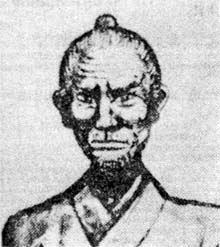KODENKAN of Phoenix

MATSUMURA SEITO-HA
Biography of
Sokon "Bushi" Matsumura
1797-1889
 |
Sokon Matsumura, also known as Bushi (Warrior) Matsumura and Shuri Matsumura (1797-1889), was one of the most renowned martial artists of his time. He was known as a master "par excellence" and the organizer and founder of Shorin Ryu Karate. Matsumura is responsible for carrying on the teachings of the old Shuri-Te martial arts. Matsumura chose the name Shorin Ryu (Shaolin Ssuin Chinese) as the name of his Ryu because it is related back to the Shaolin Temple in China, renowned for its fighters. Although some authorities believe that Anko Itosu (1830-1915), Matsumura's student, is actually responsible for adopting the name Shorin Ryu.
|
Matsumura was recruited into the service of the Sho family (Royal family of Okinawa) and eventually became the chief martial arts instructor and bodyguard for the Okinawan King. At some point in his career, approximately 1830, he went to China and studied the Shaolin style of Chinese Kenpo (fist method) and weaponry.
It is also known that he traveled to Foochow in Fukien province, China on numerous occasions as an envoy for the Okinawan King. After his return from China he organized and refined the Shorin Ryu system of Okinawan Karate. Matsumura is credited with passing on the kata or formal exercises of Shorin Ryu Karate known as Naihanchi I & II, Passai Dai (Matsumura no Passai), Seisan, Chinto, Gojushiho (fifty-four steps of the Black Tiger), Kusanku (the embodiment of Kusanku's teaching as passed on to TodeSakugawa) and Hakutsuru (white crane).
The Hakutsuru kata contains the elements of the white crane system taught within the Shaolin system of Chinese Kenpo. Another set of kata, known as Chanan in Matsumura's time, is said to have been devised by Matsumura himself and was the basis for Pinan I and II. Matsumura's Ryu has endured to the present day and the above mentioned kata are the core of Shorin Ryu Karate today. Matsumura was given the title "Bushi" meaning warrior by the Okinawan King in recognition of his abilities and accomplishments in the martial arts. In fact, Matsumura fought many times but was never defeated.
His martial arts endeavors, specifically the organization of Okinawan Shorin Ryu system has been the progenitor of many contemporary karate styles, Shotokan Ryu and Shito Ryu, for example. Ultimately all modern styles of karate that evolved from the Shuri-Te lineage can be traced back to the teachings of Bushi Matsumura. This includes Tae kwon Do (Korean Karate). Tae kwon Do was founded in 1955 by General Choi Hung Hi, a member of the Korean Army. According to General Hi, "Tae kwon Do is a synthesis of Taekyon, an ancient Korean form of unarmed combat which mainly employs kicking and karate, a Japanese martial art which chiefly relies on hand techniques". General Hi, the father of Tae kwon Do, studied Shotokan Karate in Kyoto while he was a college student in Japan.
Bushi Matsumura before his death passed on his menkyo kaiden (certificate of full proficiency) to his grandson, Nabe Matsumura.
Shorin-ryu
is the Japanese pronunciation of the Chinese characters pronounced
"Shaolin" in Mandarin-Chinese. Shorin/Shaolin means "small forest";
"ryu" simply means "methods handed down," "methods of
learning" such as those of a school, or "tradition
Designed by MDA. Ltd., April 2002